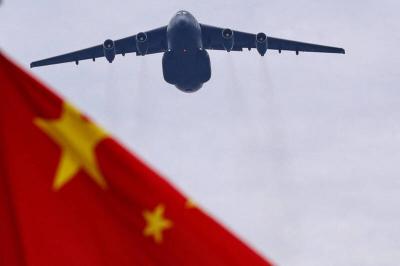As long as one accepts the “one China” principle, all other questions are open for discussion, China’s Taiwan Affairs Office (TAO) spokesman Yang Yi (楊毅) said of the controversial “one country, two areas (一國兩區)” proposal yesterday.
The proposal was made by former Chinese Nationalist Party (KMT) chairman Wu Po-hsiung (吳伯雄) on Thursday last week during a meeting with Chinese President Hu Jintao (胡錦濤) in Beijing.
Wu was scheduled to conclude his visit to China and return to Taipei yesterday.
He said at the time that based on the legislative and political systems in China and Taiwan, “we both insist on the concept of ‘one country,’ but we have differing definitions as to what ‘one country’ means.”
“We should agree on overlapping definitions, that China and Taiwan are territories under ‘one China,’ while accepting the differences, concentrating on the real-world situation and putting bickering aside,” Wu said.
At the start of a regular press conference yesterday, Yang listed the results of the Wu-Hu meeting, saying that an important consensuses had been reached and the direction the two sides should work toward had been clarified.
This increased mutual trust in political matters, Yang said, adding that he hoped both parties would work together to promote the peaceful development of cross-strait relations to benefit people on both sides of the Taiwan Strait.
One result of the Wu-Hu meeting was acceptance that cross-strait relations had improved dramatically over the past four years and were now at their most stable state in 60 years, Yang said.
A majority of people in Taiwan and China accept the need for peaceful cross-strait development, a policy welcomed and affirmed by the international community, he added.
Wu and Hu agreed that the KMT and the Chinese Communist Party (CCP) should be “responsible to the people and to history” and seize the opportunity for improved cross-strait relations, Yang said.
Agreeing to commonalities and accepting differences would make it easier to increase mutual trust, develop beneficial interactions, strengthen cooperation and build goodwill, Yang said, adding that peaceful cross-strait relations would benefit all “Chinese.”
Wu and Hu also agreed that both parties and governments should work to enhance political trust, hold to the principles of “opposition to Taiwan independence and affirm the [so-called] ‘1992 consensus.’”
This would involve establishing a clearer international consensus that both sides of the Strait subscribe to the idea of “one China,” Yang said.
The fourth area of agreement was that people on both sides of the Taiwan Strait are “Chinese” and that the “Taiwanese consciousness of loving both the land and their homes is different to the pro-Taiwan independence consciousness,” Yang said.
Wu and Hu also agreed to the continued promotion of cross-strait economic and cultural interaction to the mutual benefit of people on both sides of the Taiwan Strait, he added.
Meanwhile, Yang said China welcomed members of the Democratic Progressive Party (DPP) to attend academic forums as academics, especially those related to Taiwanese affairs.
Yang’s comments referred to a visit by DPP spokesman Lo Chih-cheng (羅致政), who attended a two-day academic forum chaired by the Taiwan Affairs Office think tank, the Research Center for Relations Across the Taiwan Straits, earlier this month.
In response to questions about the regulation of cross-strait education and cultural events this year, Yang said that the Taiwan Affairs Office was looking to sign an accord with Taiwan that would establish mechanisms for cultural and educational interaction.
As to a suggestion made by academics at a conference in Taiwan at the weekend that a military trust mechanism could be introduced in stages, Yang said China welcomed academic discussion on the matter.
“We support both sides of the Strait interacting and debating military issues at an appropriate time in order to establish mechanisms to foster mutual trust in military matters,” he said.

Beijing could eventually see a full amphibious invasion of Taiwan as the only "prudent" way to bring about unification, the US Department of Defense said in a newly released annual report to Congress. The Pentagon's "Annual Report to Congress: Military and Security Developments Involving the People's Republic of China 2025," was in many ways similar to last year’s report but reorganized the analysis of the options China has to take over Taiwan. Generally, according to the report, Chinese leaders view the People's Liberation Army's (PLA) capabilities for a Taiwan campaign as improving, but they remain uncertain about its readiness to successfully seize

HORROR STORIES: One victim recounted not realizing they had been stabbed and seeing people bleeding, while another recalled breaking down in tears after fleeing A man on Friday died after he tried to fight the knife-wielding suspect who went on a stabbing spree near two of Taipei’s busiest metro stations, Taipei Mayor Chiang Wan-an (蔣萬安) said. The 57-year-old man, identified by his family name, Yu (余), encountered the suspect at Exit M7 of Taipei Main Station and immediately tried to stop him, but was fatally wounded and later died, Chiang said, calling the incident “heartbreaking.” Yu’s family would receive at least NT$5 million (US$158,584) in compensation through the Taipei Rapid Transit Corp’s (TRTC) insurance coverage, he said after convening an emergency security response meeting yesterday morning. National

Taiwan has overtaken South Korea this year in per capita income for the first time in 23 years, IMF data showed. Per capita income is a nation’s GDP divided by the total population, used to compare average wealth levels across countries. Taiwan also beat Japan this year on per capita income, after surpassing it for the first time last year, US magazine Newsweek reported yesterday. Across Asia, Taiwan ranked fourth for per capita income at US$37,827 this year due to sustained economic growth, the report said. In the top three spots were Singapore, Macau and Hong Kong, it said. South

PLANNED: The suspect visited the crime scene before the killings, seeking information on how to access the roof, and had extensively researched a 2014 stabbing incident The suspect in a stabbing attack that killed three people and injured 11 in Taipei on Friday had planned the assault and set fires at other locations earlier in the day, law enforcement officials said yesterday. National Police Agency (NPA) Director-General Chang Jung-hsin (張榮興) said the suspect, a 27-year-old man named Chang Wen (張文), began the attacks at 3:40pm, first setting off smoke bombs on a road, damaging cars and motorbikes. Earlier, Chang Wen set fire to a rental room where he was staying on Gongyuan Road in Zhongzheng District (中正), Chang Jung-hsin said. The suspect later threw smoke grenades near two exits